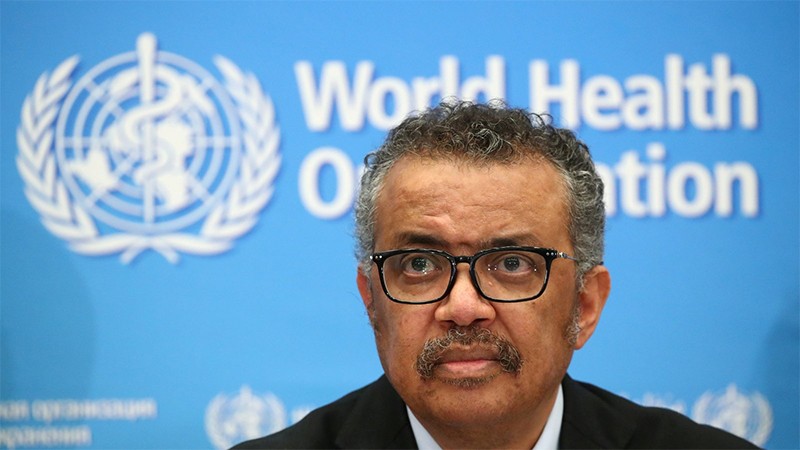05/01/2023
05/01/2023

GENEVA, Jan 5, (Agencies): The head of the World Health Organization said Wednesday the agency is “concerned about the risk to life in China” amid the coronavirus’ explosive spread across the country and the lack of outbreak data from the Chinese government. WHO Director-General Tedros Adhanom Ghebreyesus said the agency recently met with Chinese officials to underline the importance of sharing more details about COVID- 19 issues including hospitalization rates and genetic sequences, even as the pandemic continues to recede globally since it began in late 2019.
“Data remains essential for WHO to carry out regular, rapid and robust risk assessments of the global situation,” Tedros said at a press briefing. Tedros said he understood why numerous countries have recently taken measures against travelers coming from China, saying “it’s understandable that some countries are taking steps to prevent their citizens” given the void of information about COVID-19. WHO emergencies chief Dr. Michael Ryan said the testing protocols implemented by some countries were not a restriction against travel.
“It’s not an excessive measure based on individual countries’ risk assessment,” Ryan said. He noted that for the past three years, China has had some of the world’s harshest rules regarding COVID-19. “The reality for China is that many countries (now feel) they don’t have enough information to base their risk assessment,” he said. Earlier this week, Chinese officials sharply criticized COVID-19 testing requirements imposed on visitors from China and threatened countermeasures against countries involved, which include the U.S. and several European nations. “We believe that the entry restrictions adopted by some countries targeting China lack scientific basis, and some excessive practices are even more unacceptable,” Foreign Ministry spokesperson Mao Ning said at a briefing Tuesday.
Concerns
The WHO’s Ryan added that there were continuing concerns about how Chinese officials are recording coronavirus deaths, saying that their definition, which only counts COVID-19 deaths if there is a record of respiratory failure, is too narrow. Throughout December, China recorded only 13 official COVID-19 deaths, despite many thousands of cases every day and reports about overwhelmed hospitals, fever clinics and crematoriums. A WHO expert group said Wednesday that no worrying new COVID variants have been identified in China based on the information authorities have shared, including genetic sequences deposited into a public database.
The WHO said Chinese scientists have now shared more than 770 sequences, with omicron subvariants BA.5 and its descendants accounting for more than 97% of all local infections. Globally, BA.5 variants comprise about 68% of all sequences. The European Centre for Disease Prevention and Control said it did not expect the surge of COVID- 19 in China to affect the outbreak in Europe, given the high rates of vaccination across the continent. It also noted that the variants spreading in China were already present in Europe, suggesting that any spillover from China would have a negligible impact.
According to Dr. Maria Van Kherkove, the WHO Technical Lead for COVID-19X, BB.1.5 was initially detected in October 2022. It is the most transmissible subvariant yet. “We do expect further waves of infection around the world, but that doesn’t have to translate into further waves of death because our countermeasures continue to work,” she said. Dr. Van Kherkove emphasized the importance of continued COVID-19 surveillance around the world to track known subvariants that are in circulation. Last month, more than 13 million cases of the disease were reported, though WHO believes the toll is higher,
Trends
“But more concerning, we’ve had a 15 percent increase in deaths in the last month and again, we know that that is an underestimate because there are delays in reporting, and with the holiday period and with mixing, those trends are expected to continue,” said Dr. Van Kherkove. Hong Kong will start to reopen its border with mainland China on Sunday and allow tens of thousands of people to cross from each side every day without quarantine, the city’s leader said.
The city’s land and sea border checkpoints with the mainland have been largely closed for almost three years under China’s “zero-COVID” strategy, which has restricted entry to the country, isolated infected people and locked down areas with outbreaks. The reopening is expected to provide a much-needed boost to Hong Kong’s economy.
Thursday’s announcement came as China is easing some of the world’s toughest anti-virus controls. From Sunday, China will also gradually increase the number of flights between Hong Kong and the mainland and scrap the limit on passenger numbers for flights from the city, the Chinese government said in a statement. “My personal inclination is, if factors permit, I want to allow a large number of people to go through because that has been the voice of a lot of people, both locally and overseas — wishing Hong Kong to proceed to normalcy as quickly as possible,” Chief Executive John Lee said at a press conference. During the first phase of the reopening, four border checkpoints that were closed for nearly three years will resume operations, bringing the number of checkpoints up and running in the city to seven, Lee said. Currently, all but three checkpoints in Hong Kong are shut.


